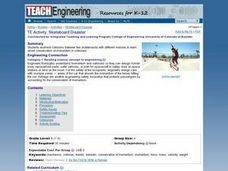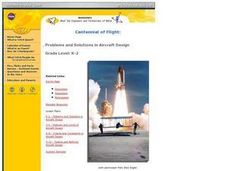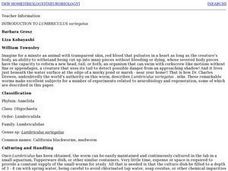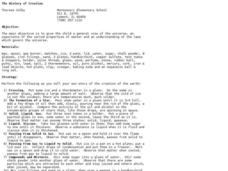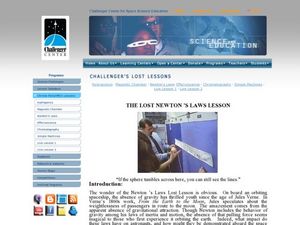Curated OER
Magnify It!
Students view objects of various sizes from several viewing distances to discover that their visual field is limited. They record what they see and compare their observations with classmates. They conduct more structured experiments.
Curated OER
Skateboard Disaster
Students conduct a hands-on experiment with collisions between two skateboards of different masses. They are introduced to the concept of conservation of momentum in collisions and consider how their observations might help engineers...
Curated OER
Sitting on Nails-Boyle's Law
Students experience pressure as a force per unit area in this experiment with a board of nails. In this physics lesson, students discover Boyle's law as they perform experiments with pressure.
Curated OER
What is a greenhouse?
Students experiment to gain understanding of how a greenhouse retains heat. In this greenhouse lesson, students work with soda bottles and simulate a greenhouse. Students compare data from a vented and intact bottle. Students...
Curated OER
Problems and Solutions in Aircraft Design
Students watch demonstrations of paper folded designs that do and do not fly and discuss their observations. They identify problems that they, the Wright Brothers, or NASA scientists face when designing an aircraft, and identify...
Curated OER
Gravity Gets You Down
Students investigate the force of gravity and how it effects different objects that are put into acceleration when applied the experiment of free falling. They drop different objects that have a variety of masses and some that cause air...
Curated OER
Flight Dreams - Flight Factors
Students investigate the physics of flight by experimenting in class. In this history of flight instructional activity, students define terms such as gravity, lift, and drag in order to better understand how a plane is able to stay...
Curated OER
Warm Air versus Cold Air
Students discover that warm air takes up more space than cold air. In this science lesson, students perform 4 experiments using balloons to determine that the molecules of warm air are more spread out than those of cold air.
Curated OER
Oil Spill
Students explore an important role of environmental engineers by studying the Exxon Valdez oil spill. They experiment with different strategies in order to clean up their own manufactured oil spill.
Curated OER
Introduction to Lumbriculus variegatus
Students conduct two set experiments on Lumbriculus worms and create a third experiment of their own. The first of the two set experiments allows students to observe regeneration of the worms while the second allows students to test the...
Curated OER
Wilderness Survival: A Field Practicum
Students use hands-on field-testing of authentic application from principles pertaining to: Psychology- A. Develop a positive, can-do attitude with a high degree of self-reliance that is transferable to human interactions outside of the...
Curated OER
Do the Twist...(Learning about Screws)
Young scholars investigate how screws are a twisted incline plane. They observe the teacher screw a screw into wood and participate in a class discussion. Next, they make and test a prediction about how the spacing of the threads on a...
Curated OER
Basic Needs of Plants
Second graders conduct a plant experiment. In this basic needs of plants activity, 2nd graders observe plants for two weeks. Students record data from their plants in journals.
Curated OER
Air Pressure
Students perform experiments that demonstrate the characteristics of air pressure. For this physics lesson, students participate and observe experiments using simple household items. The results of these experiments are used to help the...
Curated OER
The Flying Paperclip
Students investigate items that interrupt magnetic fields. In this physics lesson, students explain why the paper clip in the experiment seems to fly. They write a detailed explanation of what they did in this activity.
Curated OER
Magnets
Students demonstrate the process of science by posing questions and investigating phenomena through language, methods and instruments of science as they experiment at four teacher-created stations to explain the fundamentals of magnetism.
Curated OER
Microorganism Multiplication
Sixth graders conduct experiments with yeast to study characteristics of microorganisms. They, working is small groups, change the variables in the experiments and note the results which they later discuss as a class.
Curated OER
How Things Fly
Students will examine the physics of flight through using experimental inquiry. In this lesson, you'll introduce your students to the four forces of flight--drag, lift, thrust, and weight--through a variety of fun-filled flight...
Curated OER
Wilderness Survival: A Field Practicum
Students are provided with hands-on-field testing of authentic applications from principles pertaining to: Psychology A. Develop a positive, can-do attitude with a high degree of self-reliance that is transferable to human interactions...
Curated OER
The Universe
Middle schoolers describe what scientists mean by an "expanding universe" in their own words. They explain how scientists comprehend the universie is expanding. Students comprehend the vast scale of the universe. They comprehend how...
Curated OER
The History of Creation
Students explore the properties of matter. In this lesson about matter, students will do a series of experiments to enable them to understand about creation of the universe. In these some of the experiments students will makes stars,...
Curated OER
Objects Race 500
Students explore the concept of "shape affects speed" through a series of experiments. In this physics lesson, students participate in an experiment in which various objects are released on an inclined plane. Speed and distance are...
Curated OER
The Lost Newton's Laws Lesson
Students explore momentum. In this physics lesson, students perform an experiment in which two balls are released on slanted boards while students observe which ball will go the farthest and the fastest. Students define and explain...
Curated OER
Moon: NC Summer Tour Lesson 2007
Young scholars investigate craters and marea. In this crater and marea lesson, students conduct an experiment to create craters. Young scholars participate in a dance activity.

